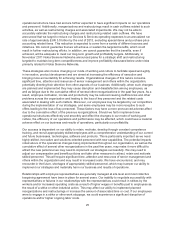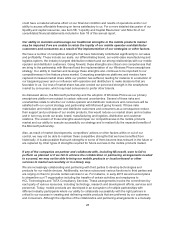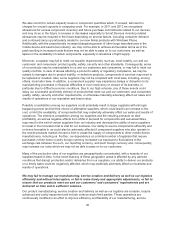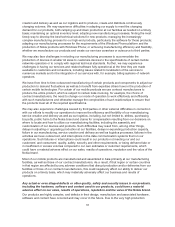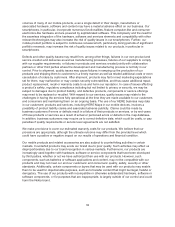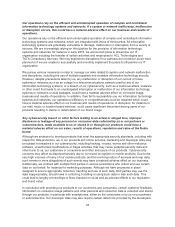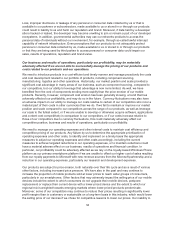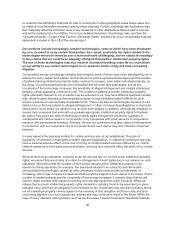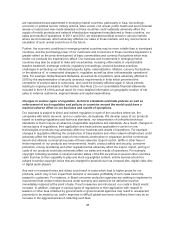Nokia 2012 Annual Report Download - page 35
Download and view the complete annual report
Please find page 35 of the 2012 Nokia annual report below. You can navigate through the pages in the report by either clicking on the pages listed below, or by using the keyword search tool below to find specific information within the annual report.Loss, improper disclosure or leakage of any personal or consumer data collected by us or that is
available to our partners or subcontractors, made available to us or stored in or through our products
could result in liability to us and harm our reputation and brand. Moreover, if data held by a developer
site is hacked or leaked, the developer may become unwilling to join or remain a part of our developer
ecosystems. In addition, governmental authorities may use our networks products to access the
personal data of individuals without our involvement, for example, through so-called lawful intercept
capability of network infrastructure. Even perceptions that our products do not adequately protect
personal or consumer data collected by us, made available to us or stored in or through our products
or that they are being used by third parties to access personal or consumer data could impair our
sales, results of operations, reputation and brand value.
Our business and results of operations, particularly our profitability, may be materially
adversely affected if we are not able to successfully manage the pricing of our products and
costs related to our products and our operations.
We need to introduce products in a cost-efficient and timely manner and manage proactively the costs
and cost development related to our portfolio of products, including component sourcing,
manufacturing, logistics and other operations. Historically, our market position and scale provided a
significant cost advantage in many areas of our business, such as component sourcing, compared to
our competitors, but our ability to leverage that advantage is now more limited. As well, we have
benefited from the cost of components eroding more rapidly than the price erosion of our mobile
products. Recently, however, component cost erosion has been generally slowing, a trend that has
adversely affected our profitability, and may do so in the future. Currency fluctuations may also have
an adverse impact on our ability to manage our costs relative to certain of our competitors who incur a
material part of their costs in other currencies than we do. If we fail to maintain or improve our market
position and scale compared to our competitors across the range of our products, as well as leverage
our scale to the fullest extent, or if we are unable to develop or otherwise acquire software, applications
and content cost competitively in comparison to our competitors, or if our costs increase relative to
those of our competitors due to currency fluctuations, this could materially adversely affect our
competitive position, business and results of operations, particularly our profitability.
We need to manage our operating expenses and other internal costs to maintain cost efficiency and
competitive pricing of our products. Any failure by us to determine the appropriate prioritization of
operating expenses and other costs, to identify and implement on a timely basis the appropriate
measures to adjust our operating expenses and other costs accordingly, including the current
measures to achieve targeted reductions in our operating expenses, or to maintain reductions could
have a material adverse effect on our business, results of operations and financial condition. In
particular, our profitability could be adversely affected as we rely on the royalty-based Windows Phone
platform as our primary smartphone platform if we are unable to offset our higher cost of sales resulting
from our royalty payments to Microsoft with new revenue sources from the Microsoft partnership and a
reduction in our operating expenses, particularly our research and development expenses.
Our products are subject to price erosion, both naturally over their life cycle and as a result of various
other factors, including increased price pressure. We have also in the past and may continue to
increase the proportion of mobile products sold at lower prices to reach wider groups of consumers,
particularly in our smartphones. Other factors that may adversely impact the selling price of our mobile
devices include the extent to which consumers do not upgrade their mobile devices, postpone
replacement or replace their current device with a lower-priced device and the extent to which our
regional mix is weighted towards emerging markets where lower-priced products predominate.
Moreover, some of our competitors may continue to reduce their prices resulting in significantly lower
profit margins than is customary or sustainable on a long-term basis in this industry, which would lower
the selling price of our devices if we chose for competitive reasons to lower our prices. Our inability to
34



